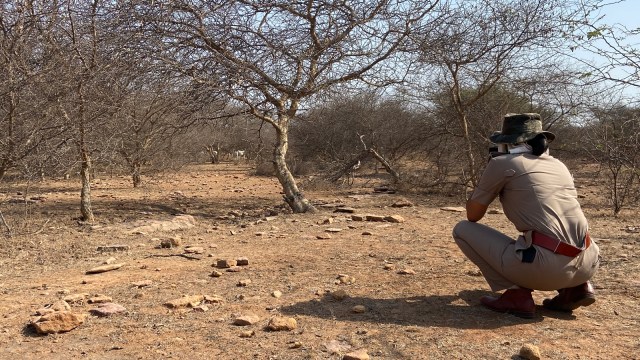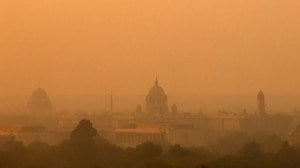Population survey begins: At Surendranagar villages, herds of wild asses easy to spot but hard to click
Forester Jaydeepsinh Zala snaps photographs, range forest officer Vilasben Antala crouches with a DSLR for better resolution photos of the herd.
 Range forest officer Vilasben Antala tries to capture wild asses on Tuesday. (Express Photo by Sohini Ghosh)
Range forest officer Vilasben Antala tries to capture wild asses on Tuesday. (Express Photo by Sohini Ghosh)Hiding behind babool trees and thorny shrubs, Jivanbhai Bharvad, a resident of Bavali village in Surendranagar, is quick to spot the group of four pale sandy-coloured wild asses. While forester Jaydeepsinh Zala snaps photographs, range forest officer Vilasben Antala crouches with a DSLR for better resolution photos of the herd.
The three are part of the two-day ’10th Wild Ass Population Estimation’ (WAPE) exercise conducted every five years by the Gujarat forest department, launched on Tuesday. They are looking for the Equus Hemionus Khur breed, one of the two sub-species of Indian wild assess that is only found in the Little Rann of Kutch in India. The last WAPE held in 2020, delayed by a year because of excessive rain, pegged the population at 6,082, spread over Surendranagar, Morbi, Kutch, Ahmedabad, Patan and Banaskantha districts.
On Tuesday, no sooner does the team of forest officials, assisted by Bharvad, cautiously approach the herd to get a closer look, the animals run away. The next one hour is spent attempting to get a closer look at the herds that are frequently sighted, but with little luck.
“This is the thing with spotting wild ass in an area like this, covered by babool trees and thorny shrubs. You will see a number of them but we won’t be able to photograph them clearly,” says Antala.
However, even as temperature touched 44 degree Celsius in Surendranagar on Tuesday afternoon, the forest officials remained unfazed, as it was their good fortune that Bavali village is a part of a reserved forest – estimated to measure around 200 hectare and bordered by a large water source, Falku dam — providing a safe haven for the wild asses, making their sightings abundant.
 Bharat Ranpara accompanied by locals scan for wild asses near watering holes at Bhechda village in Surendranagar. (Credit: Sohini Gosh)
Bharat Ranpara accompanied by locals scan for wild asses near watering holes at Bhechda village in Surendranagar. (Credit: Sohini Gosh)
But nearly 10 km away at Bhechda village, the forest officials are not so lucky. Forester Bharat Rangpara asks one question to every villager he encounters – “Have you seen wild asses anywhere nearby?”
The question is often answered in the negative, with a few villagers giving a tinge of hope to Rangpara when they say, “Yes, a couple of them frequent at night.”
The villagers, however, unanimously complain – “The Nilgais and wild asses destroy our crops. It would be fine if they just ate and left but they trample all over, destroying crops.” A villager, Hardevsinh, says, “They come at night so I have to sit and guard my fields at night as well.”
 Wild Ass Survey Highlights
Wild Ass Survey Highlights
Rangpara is quick to exchange numbers and instructs them, “Call me immediately whenever you spot one either today or tomorrow. The forest department is carrying out a census of wild asses.”
In a bid to take the villagers into confidence, Rangpara adds: “Many villagers are complaining about destruction of crops and that they have complained to the forest department to move them out of the area. But the department can’t help you unless we know if there are wild asses and how many of them are here. So, let us know if you spot any either today or tomorrow.”
Rangpara, accompanied by two villagers, snakes through every lane of the village and its surrounding areas on a bike. He stops at every watering hole and scans for any sightings of wild asses – what is fast turning out to be an elusive animal in Bhechda. “In summers, they frequent watering holes,” says Rangpara. By the end of the day, Rangpara had not spotted a single wild ass in the village. He hopes to be lucky on Wednesday.
 Reserve forest area in the Bavali village (Credit: Sohini Gosh)
Reserve forest area in the Bavali village (Credit: Sohini Gosh)
The two-day population survey for wild asses includes the first day of preliminary count and the second day of final count. Antala says, “Wild asses keep moving from territory to territory and there are overlaps in the territories. So say, if we saw 21 wild asses in Bavali today and we see fewer tomorrow, the final count for Bavali will go as what we record tomorrow. The numbers will be adjusted eventually because a herd may have moved to another territory or village, and it will get counted there.”
Part of conducting the survey also includes classifying the sightings as “male”, “female” or “seen but (gender) not known”. Bharvad – with his father and grandfather having worked with the forest department – was hired as a chowkidar at the Van Chetna Kendra at Bavali, situated inside the reserved forest area. He can identify specific herds and is a crucial piece in the puzzle for the forest department to estimate the wild ass population.
For the survey, the teams include one forester and two villagers from the area to be studied. The numbers are then reported to the range forest officer, such as Antala, who is dealing with five villages comprising a sub-zone.
While villagers at Bhechda want wild asses gone, Bharvad says, “I have 30 bigha of land where I grow crops such as cotton and groundnut, among others. The wild asses do come into the field and destroy the produce but I don’t mind, we have learnt to live together. I think there must be around 200 wild asses covering the entire reserved forest area.”
 Forester Jaydeepsinh Zala and local Jivanbhai Bharvad at Bavali as the latter takes the forest officials around for the wild ass population estimation count (Credit: Sohini Ghosh)
Forester Jaydeepsinh Zala and local Jivanbhai Bharvad at Bavali as the latter takes the forest officials around for the wild ass population estimation count (Credit: Sohini Ghosh)
Bavali is one of the four villages over which the reserved forest area is spread, says Antala, adding that the villagers counted two herds of 17 and four wild asses as on Tuesday afternoon.
Zala, assigned enumeration at Bavali, is otherwise posted at Rajkot. “We are from outside. So, without them (villagers) we cannot do this. We would not even know where to start from,” he says.
What a survey day looks like
Survey time: Day 1
6 am to 7 pm
6 – 9 am
At Bhechda, forest guard starts the day, coordinates with the two locals who will assist him, arrange for vehicles to travel in and around the village, runs a basic scouting of the terrain where the survey is to be conducted.
9 am – 12 pm
Forest guard Bharat Rangpara goes around the village in his bike, visiting and stopping at waterholes, areas where locals suggest they have seen wild asses in the past, scans possible habitats in search of wild ass
12 pm – 3 pm
Forest and forest guards of three villages, along with the locals assigned to assist them, gather at a village temple for lunch and siesta amid the rising temperature
3pm- 6 pm
Foresters and forest guards disperse back to their jurisdictions to continue the survey. At Bavali, forester Jaydeepsinh Zala goes out for round two along one side of a reserved forest area in the Bavali village
6pm to 7 pm
Zala goes out for a third round along with a local.
Foresters of five villages comprising a subzone then send the numbers recorded from their respective jurisdiction to the regional forest officer they are reporting to.







